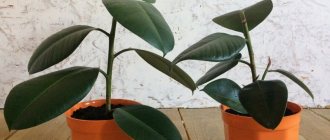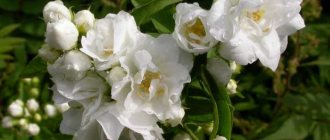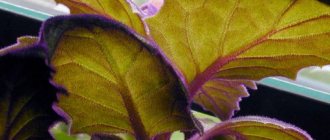Ficus elastica is often found among lovers of indoor flowers. It can decorate any interior with itself, and it also perfectly refreshes the room. I also like it because ficus rubber plants require simple care at home; even inexperienced people can handle it.
Under human care, its height rarely exceeds a couple of meters; side shoots almost never depart from the main stem. It owes its popularity to its mirror-like shine.
Flowers are not of interest, and they only appear in nature. It exudes rubber, hence its name. The second name is elastica.
Carefully! The plant secretes juice. If it gets on the skin, it can cause a rash, irritation or allergies.
Houseplant Ficus elastica - description
Ficus rubber (Elastica) (F. elastica) belongs to the Mulberry family. Its homeland is considered to be India, as well as Sumatra and Java. In the east, this tree has been held in high esteem since ancient times and is sacred to followers of Buddhism. In total, the genus Ficus contains about 600 species of plants that can be found throughout Asia, and some of them have been successfully cultivated and taken root in indoor conditions.
In nature, Ficus elastica can grow up to 30-40 m in height, but in indoor conditions it is unlikely to exceed 2.5 m. At the same time, adult, overgrown Ficuses often take down aerial roots that grow from the branches and trunk, going down. Thickets of aerial roots form real forests, and such Ficuses are called banyans.
The most magnificent part of the Ficus elastica is its leaves. The shape of the leaves is oval, slightly pointed at the end, up to 30 cm long and 15 cm wide. The surface of the leaf blade is shiny, dark green or olive in color. There are varieties and varieties with variegated leaves, which are decorated with light spots and a bright border. New leaves appear rolled into tubes and wrapped in reddish stipules, which eventually fly off. Each leaf is located alternately along the entire length of the stems and is planted on a short leaf petiole.
Flowering of the homemade Ficus Elastica is a very rare and almost impossible phenomenon. In nature and greenhouse conditions, it blooms with inconspicuous flowers, which over time are replaced by inedible fruits similar to figs.
Ficus rubbery received its name due to the milky sap that is released when the plant trunk is damaged. Previously, this tree was grown on an industrial scale and used to produce rubber. In addition, the plant juice contains alkaloids, so you should avoid getting it on the skin and mucous membranes, as it can cause severe irritation.
The beautiful Ficus Elastica certainly cannot be called a fast-growing plant. Even if it is grown in favorable conditions and receives good care, in 1 year the plant gains only 40-50 cm. At the same time, home ficuses usually grow with one trunk, almost do not branch and do not form lateral shoots.
Humidity
Ficus elastica tolerates normal room humidity well, but, like most tropical plants, it loves high humidity.
It’s easy to provide – just daily spraying .
You can simply place a humidifier or a container of water nearby. This will improve the appearance of the plant and have a positive effect on its growth.
In the summer, ficus responds well to a warm shower . It is better to carry out the bath procedure in the evening and leave the plant in the bath overnight until the leaves are completely dry. Or wipe wet leaves dry with a soft cloth.
If you expose a wet plant to the sun's rays, sunburn in the form of brown spots may appear on the leaves, which will affect the health of the flower and its decorative appearance.
Also, from time to time, the leaves are wiped with a damp sponge to remove dust. In addition to cleansing, this hygienic procedure has a positive effect on plant growth.
How to care for ficus Elastica at home
Caring for Ficus rubber is not particularly difficult. Minimal knowledge in plant growing and a little effort will allow even a novice indoor flower lover to grow this unpretentious plant.
What to do after purchase
Immediately after purchasing Ficus Elastic, you need to quarantine it for 2 weeks. The plant is set aside from other house flowers, carefully examined for diseases and pests and, if necessary, treated with special preparations. If there are traces of disease on the plant, it is treated with fungicides according to the instructions, for example, Fitosporin. If harmful insects are detected, the tree is sprayed with an insecticide according to the instructions.
There is no point in replanting a newly purchased plant. It is necessary to give him a couple of months to adapt, since he does not tolerate changes in place and conditions of detention.
Lighting
Direct sunlight can leave unsightly burns on ficus leaves, however, this plant is quite light-loving and prefers to receive a lot of diffused light. Variegated varieties especially need good lighting; under no circumstances should they be pushed into a corner or placed in the shade, otherwise the leaf blades will lose their characteristic color over time.
The southern, eastern or western side of the house is ideal for placing Ficus Rubber. The plant is placed on the windowsill and shaded with a curtain or placed near the window on the floor, table or stand, depending on the size of the tree. If you place the pot in the shade, the flower will not die, but will stop growing and shed its lower leaves. Then the tree will not look as chic as in brighter lighting.
Temperature
For growing, a normal room temperature of about +20-+250C or higher is suitable, but at higher humidity levels. In spring and summer, a pot of ficus can be taken out to the veranda, balcony or garden. In the cold season, it is advisable to keep the flower in cooler conditions, but make sure that the thermometer does not fall below +150C, otherwise the tree will quickly shed its leaves. You also need to protect the plant from drafts and sudden changes in temperature, and if it is on a cold windowsill, then foam plastic should be placed under the pot.
Humidity
When the humidity level is low, the tips of the ficus leaves begin to dry out. In the warm season, they try to spray it every day with a spray bottle and periodically clean the leaves from dust. It is also recommended to wash the plant once a month under a warm shower, but at the same time you need to cover the surface of the soil with a film. In winter, spraying is stopped, but the flower is removed away from working batteries. It is important to keep your ficus leaves clean at any time of the year. It is wiped with a damp cloth or dust cloth. You cannot treat the leaves of the plant with special polishing compounds, since a clean and healthy Ficus Elastica will always look attractive, and when such products are used, it begins to shed its leaves.
Watering
Watering is adjusted depending on the size of the plant itself and external conditions. It is advisable to water as the top layer of the contents of the pot dries to a depth of 2 cm.
In summer
In the warm season, spring and summer, the ficus is watered 1-2 times a week, when the top layer of soil dries out. Watering should be plentiful, but do not allow moisture to stagnate. All water that has flowed into the pan is immediately drained.
in winter
In the cold season, watering is done moderately once a week. Excessive moisture of the substrate when kept cool threatens rotting of the roots.
Fertilizer and feeding
In order for Ficus Elastica to grow well and develop harmoniously, from the beginning of spring to the end of summer it is fed with mineral compounds and organic matter 2 times a month. Drugs can be alternated. All fertilizers are applied at the root and in no case are sprayed on leaves, growing points and stems. In the cold season, all feeding is stopped. Nitrogen preparations will help accelerate the growth of ficus and the appearance of new leaves in the spring.
Pruning and crown formation
Over the years, ficus leaves fall off at the bottom of the trunk, so periodic pruning and trimming is very important to maintain the decorative appearance of the plant. This will help not only give the tree splendor, but also restrain its rapid growth. Often, domestic ficuses grow with one trunk, but in order for it to begin to branch, it is useless to pinch and trim its top, for this you need to cut off at least 5-6 internodes, then the lower buds can awaken, from which new branches will grow.
If the Ficus Elastica has become too elongated, you can cut off the unevenly developed branches and root them in the same pot. Then the bush will grow more lush and dense. To limit the growth of ficus in height, you can periodically pinch the upper parts of the branches.
Young ficus trees can be made more magnificent by bending the upper part of the stem. It is bent to the maximum and secured. After the topmost bud gives off a side shoot, the plant is straightened.
To increase branching, some gardeners practice piercing the stem with a thin needle to a depth of 1/3 of the trunk. Punctures begin to be left from the top of the trunk, gradually moving down.
Pruning is recommended in spring, March or April. To do this, use a sharp, clean knife, and remove the milky juice with water. When working with Ficus elastica, you need to be careful, protect your hands with gloves and try to prevent the plant juice from getting into your eyes and mucous membranes. After the procedure, wash your hands with soap and plenty of water.
Possible growing problems
Often, improper care causes the tree to feel unwell. Based on your pet’s appearance, you can determine the cause of his illness and correct the mistake in time:
- If reddish spots are found on the foliage, this does not indicate the presence of a pest. But it is a signal of a burn caused by direct sunlight. The likelihood of such a problem occurring after spraying is especially high. You just need to shade the green pet a little - and he will get better. It is important not to plunge it suddenly into darkness - light is vital.
- The leaves are deformed. This is not a symptom of any illness. Simply the plant's reaction to a stressful situation caused by setting a bud. If you maintain a high level of care, the deformed leaf will become a “point of intensive growth.”
- Not the entire surface of the sheet is deformed, but only its edges. This sign indicates problems with the root system. The problem may be caused by excessive waterlogging of the soil as a result of intensive irrigation. The solution is to significantly reduce watering. The plant is covered with a “greenhouse”. Another reason may be improper implementation of the transplant procedure. In this case, treatment with “Kornevin” will be effective.
- Red spots on leaves with drying tips are a sign of exposure to a cold draft. The plant is moved to a safe place. Watering is carried out very moderately.
- Young leaves grow not green, but brown. This is not a problem, but just a biological feature of the ficus. Improved care is required.
Conclusion
Wanting to get a beautiful and healthy plant, every amateur gardener, when purchasing a rubber ficus, must remember how to care for it at home.
Reproduction
In indoor conditions, propagation of Ficus elastica is not particularly difficult. There are several ways to obtain this wonderful plant; all that remains is to choose only the most effective and most suitable.
Cuttings
The tops or parts of the stem 10-15 cm long are suitable for this. The cuttings are cut at an angle and only 1-2 upper leaves are left, washed from the milky juice under the tap with warm water. Cuttings can be rooted in a glass of water or directly in the substrate, only in the latter case it is advisable to cover the seedlings with a glass jar or bag on top. As a rule, cuttings of green-leaved varieties take root better, and it is better to first treat variegated varieties with root or any other root formation stimulant.
Leaf
This method of obtaining a new plant is very controversial. In most cases, the leaves take root well and take root, but, as a rule, they remain in this form for a long time. To do this, you need to separate the ficus leaf along with the leaf petiole and root it in the substrate. It will take root and take root, but new stems most likely will not appear in a month or a year.
Air layering
This method is better suited for propagating variegated varieties. A cut is made on the trunk with a depth of no more than 1/3 of the thickness, wrapped in moss and polyethylene, secured with thread or soft wire. After well-developed roots appear under the film, the cuttings are cut below the fastening and rooted in the substrate.
How to water plants correctly
There are several ways to moisten the soil. All of them are correct, but the simplest and most common is the first.
Top watering
The soil in the ficus pot should be loosened. It is recommended to use a watering can with a long thin spout. Water the substrate from above, slowly, until water begins to protrude through the drainage holes.
After 30 minutes, excess moisture is removed from the pan. In tub specimens, excess liquid can be collected using a rubber bulb. It is recommended to add it to your inventory for caring for indoor plants.
How to water a ficus in a tray
This method is usually used for Ficus pumila, which grows in a separate pot - wide and low. For other species it is recommended in winter.
Fill the pan with water. The liquid is gradually added as it is absorbed. When its volume stops decreasing and the surface of the substrate becomes wet, the remaining water is removed.
Ficus tubs cannot be watered this way. It will take so long to completely moisten the soil in large pots that it is better not to start.
Irrigation method
Dried ficuses, in which water does not linger in the substrate, but slips between the walls of the pot and the earthen lump, require immersion watering. In other cases, it is better not to use this method for ficuses.
A flower is placed in a bucket. Carefully add water so that it is 1-2 cm below the edge of the pot. When the surface of the substrate begins to shine from moisture, the ficus is removed, the liquid is allowed to drain, and returned to its original place.
Transplanting Ficus Elastica
Young plants are replanted every year, while older plants can be replanted every 2-3 years. If the Ficus elastica is large and it will be very difficult to replant it, then it is best to simply replace the top 3 cm of soil with fresh one. The plant is transferred to a new pot, trying to maintain the integrity of the earthen coma. A newly transplanted tree may be a little stressed, so don't worry if it loses a couple of lower leaves. If everything is done correctly, then after 2 weeks the Ficus Elastica will take root perfectly in its new place. When planting, expanded clay, pebbles or large pieces of brick are poured into the bottom of the pot in a layer of 4 cm.
When to replant
Ficus transplantation is carried out in spring or early summer. A signal that replanting is necessary can be roots protruding from the drainage holes or a depleted substrate.
Priming
For planting, you can use a special substrate for ficuses, but it is advisable to mix a little river sand into it to increase its breathability and drainage properties. You can prepare a substrate based on peat soil, leaf soil, turf soil and river sand, taken in equal proportions.
Pot
Choose a new pot that is stable, preferably made of durable plastic or ceramic. The bottom of the dish must have good drainage holes. The planting container should be 4-5 cm wider than the previous one and 5-6 cm higher.
Pruning and crown formation
An unformable ficus plant grows in one trunk for a long time. To form a ficus and give it more magnificent forms, the following techniques are used:
- top trimming
- planting several plants in one pot
A cutting of at least 10 cm is removed from the tallest growing part, which stimulates the revival of dormant buds and branching;
For ficus elastica, this technique is used infrequently; it is more typical for the formation of ficus Benjamin.
However, if you really want to, this option is also possible: 3 young plants are planted in one pot and gradually intertwined with each other.
This will often require removing the lower leaves.
Upon reaching the desired height, the upper parts of the crown are pinched, the shoots that appear on the trunks are removed, achieving tillering at the top. But more often they get by by simply removing the top from a single trunk.
Diseases and pests of Ficus rubber with photos and their treatment
Ficus Elastica is very resistant to most pests and almost does not suffer from harmful insects. But sometimes it can become infected with scale insects, thrips, mealybugs or spider mites.
When a mite appears on a ficus, the leaves turn yellow, become covered with tiny spots and fall off. Usually the pest appears due to too dry air and elevated room temperatures. A warm shower and wiping with soapy water will help get rid of it. If the infestation is too strong, then it is better to use insecticides and treat with Actellik.
The presence of scale insects is usually indicated by spots on the leaves covered with a sticky liquid and small dark brown growths. To help the ficus, you must first collect the parasites with a damp cloth or sponge, and then treat them with an insecticide.
Mealybugs can be identified by their whitish, fluffy discharge. They get rid of pests using garlic water or special chemicals that can be purchased at flower shops.
Thrips themselves may be completely invisible, but at the same time Ficus elastica will look sick and lethargic. Upon closer inspection, tiny specks are visible on the leaves of the plant. It is advisable to combat the parasite immediately using insecticides.
As a rule, pest infestation can be avoided if you maintain ficus hygiene and regularly wipe off dust from its leaves. Some parasites can enter the house from recently purchased plants, so it is best to quarantine new purchases for a couple of weeks and carefully monitor them.
Some gardeners may also encounter the following problems when growing Ficus elastica:
- Lack of growth. Ficus elastica does not grow in too dim light. It needs bright, diffused lighting and with a lack of sun it can completely stop growing or greatly slow down the rate of development. Also in this case, it is worth checking whether the pot is too small for him and how long ago the transplant was carried out. A lack of nutrients can also lead to a lack of significant growth over the year. Usually, when these parameters change, the plant quickly responds and begins to grow new leaves.
- Massive fall of leaves. Losing a couple of lower leaves per year, especially after replanting, is a completely natural process for this plant, but if the crown begins to thin out significantly, then you should sound the alarm and take immediate action. This is usually associated with a sharp change in temperature or a draft, so if the Ficus Rubber is frozen, then it is moved to a more protected place and they try to keep the temperature parameters at a constant level. If the ficus leaves turn yellow before they fall, this may be a consequence of irregular watering. Excess and lack of moisture is very dangerous for the plant.
- Yellow leaves. This can be caused not only by excessive watering, but also by an excess of nutrients in the substrate. Fertilizers and fertilizing must be applied strictly according to the instructions and only during the growth period, then the plant will be able to absorb all the necessary elements from the soil. If, some time after adding nutrients, the Ficus Elastica begins to turn yellow, then it needs to be thoroughly watered. After this, the plant is not fed for 3 months and watered only when the substrate is sufficiently dry.
- Root rotting. With excessive watering and an incorrectly selected substrate, the root system of Ficus elastica can be affected by root rot. Then spots appear on the stem, the leaves darken, and the plant itself gradually dies. In this case, a transplant with a complete replacement of the substrate and treatment with fungicides is necessary. If the problem is neglected, the plant may die completely, then it is better to try to root the remaining healthy parts.
- The tips of the leaves dry out. This usually happens at high temperatures and low humidity in the room. If the leaves of Ficus Elastica dry out, then it is worth reviewing the conditions of maintenance and checking the plant for the presence of pests. A healthy plant will instantly respond to changes in humidity in the room, and the damaged parts can only be removed.
Soil and feeding
For ficus, organize a substrate consisting of equal parts of turf, leaf and sandy-peat soil. Fertilizer is applied only during the period of active growth.
It is recommended to alternate organic and mineral fertilizers. In flower shops you can purchase liquid nitrogen-containing fertilizers for indoor crops.
Ficus elastica - popular species with names and photos
Some varieties of Ficus elastica have become very popular in culture. These are species with single-color leaves and Ficus elastica variegata, decorated with spots and streaks of various colors. Based on these species, several varieties that were especially popular in indoor floriculture were born, capable of decorating any room in the house.
Robusta
One of the most common types. It is a tall tree with wide glossy leaves of dark green or dark olive color. The leaf blade of adult ficus can reach a length of 30 cm, and the plant itself can reach a height of 2 m.
Tineke
Tall variety with large variegated leaves. It grows up to 2 m in height. The leaves of adult plants are up to 30 cm. The leaf blades are wide, green with a thick pinkish or white vein in the center and a white border. The variety lends itself well to pruning and can take on a lush, spreading form.
Abidjan
A powerful tree 1.5 m tall with a lush crown and almost matte wide leaf blades. The leaves reach 25 cm in length, while young leaves are almost red, and adult leaves are dark green, with yellow veins and a reddish back side.
Burgundy
The leaves of this variety are dark green, almost black, with a burgundy tint and a matte sheen, pink petioles and bright red caps. The leaf blades are elongated, about 30 cm long and about 10 cm wide.
Decor
The leaves are wide, glossy, very large, up to 30 cm long. The edges and tips of the leaf blades are curved down. The central vein of the leaf is reddish at the base, then smoothly turns into cream and soft green. The leaf color is bright green above and lighter below.
Sylvie
The leaves are wide, oval, covered with strokes and spots of creamy yellow color. The edge of the sheet also has a light edging. The leaf petioles are green with a pink tint.
Belize
The leaf blades are large, wide, about 25 cm long and 15 cm wide. As a rule, young plants are more variegated and varied in color. On one leaf blade there may be pale yellow, gray-green and dark green spots with a pinkish tint. The reverse side of the leaf is pale pink. The central vein and leaf petioles are red-pink.
Melanie
A low-growing variety with a height of no more than 30-50 cm. The leaves are dark, with a reddish tint, glossy, about 15 cm long.
Chloe
Plants of this variety grow up to 1.5 in height. The leaves are glossy, rich green. The shape of the leaves is oval, with a pointed tip. The length of the leaf plates is about 30 cm and the width is up to 20 cm.
Sofia
This species is very rare in indoor floriculture, but it looks quite unusual compared to the others. Its leaves are dark green, with an olive tint and a glossy surface. The leaf blades are wider, almost round and large, about 25-30 cm in length. The plant forms a powerful trunk. The leaves are arranged tightly to each other, forming a beautiful rosette.
Brazil
The color of the leaves is the same as that of the Belize variety. The variegated leaves with a pinkish tint do not exceed 20 cm in length, while they are more densely spaced, and the tree itself looks compact.
Black Prince
Forms a tall spreading tree with very dark glossy leaves 15-25 cm long. The color of the leaves becomes almost black at the end of the day.
Species diversity
More than 1000 species of ficus grow in their natural habitat. In indoor floriculture, the most popular varieties are Robusta, Tineke, and Belize. Despite their close relationship, each species has its own characteristics and nuances of content.
What Ficus elastica brings to the house: signs and superstitions
The luxurious leaves of Ficus Elastica are able to absorb various harmful compounds from the air and process them into amino acids and sugar, which makes this plant a welcome guest in any home.
In Eastern countries, Ficus Rubber is held in high esteem. For example, in India it is customary to give it to childless families, since it is believed that it brings the desired addition. According to Feng Shui and Ayurveda, Ficus Elastica brings calm and tranquility to the home, drives away anxiety and anger, and also helps cleanse the space of bad energy.
In Russia, the attitude towards this ficus is rather ambiguous. At one time, the plant was incredibly popular, but then it gained fame as a “husband’s herb.” If in the East Ficus elastica is considered almost a symbol of family happiness, then in Russia it is not customary to give it to unmarried girls, since there is a belief that she will never get married.
Despite all the prejudices, Ficus elastica still remains one of the most popular indoor plants, which alone can decorate a spacious room and create a bright natural accent in the interior.
How to water ficus
It is believed that for the rapid growth and well-being of indoor plants, it is better to water them with rainwater. This is only true for regions with good ecology. In the rest, you can use regular tap water. In order for the chlorine to come out, you should leave it in an open container overnight and then drain it from the sediment.
Well or artesian may be too hard, the impurities depend on the region. It is also recommended to defend it so that a crust does not form on the surface of the substrate.
It is better not to water ficus plants with boiled or purified water. It is considered “dead”, containing almost no oxygen and useful minerals.
The temperature of the liquid should be the same as in the room, or a little warmer. The cold causes shock to the roots of ficus trees.
Photos in the interior
Benefits and harms
Let's consider the benefits and harm that rubber ficus can bring to the house.
The plant cleanses the air well in any room, but the poisonous milky sap that irritates the skin limits its use as a landscaping product.
ATTENTION: Growing ficus in children's institutions is prohibited.
Thus, Ficus elastica is a good-quality, unpretentious plant that gives respectability to office premises and comfort to living rooms. The light plays beautifully on its glossy leaves.
The plant can grow in one place for more than 50 years.











